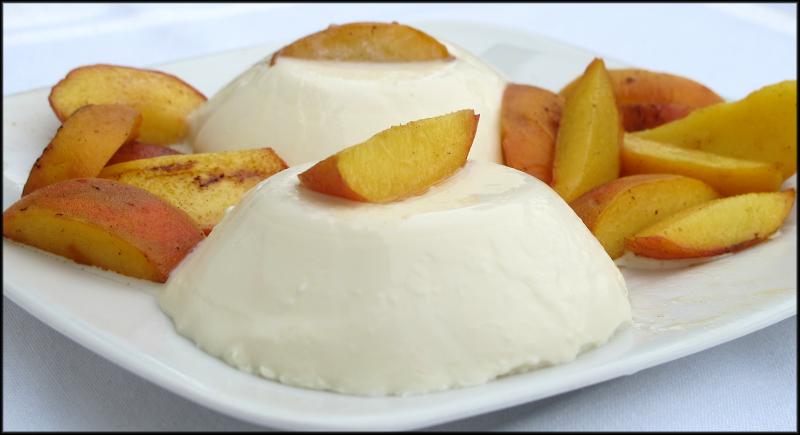Panna Cotta: Become an accidental expert
What Is panna cotta? If you had asked me that question a few weeks ago, I would have answered that it's an elegant, creamy pudding-like dessert often found on the menu at high-end Italian restaurants. I might describe the required precision in making panna cotta, to balance velvety lightness with just enough shapeliness in the finished product.
That was what I would have said based on what I had tasted a few times and a number of things I'd previously read, but not from actually making it. After three separate tries to make panna cotta last week, I now consider myself an accidental expert.
If you've ever tasted panna cotta, you'll recall the slightly sweet vanilla flavor and meltingly soft texture. By definition, panna cotta is as its name implies: cooked cream. It is made by heating cream and stirring in gelatin as a thickener. After a few hours, the mixture has settled into a quivering, but stable form.
Panna cotta is usually served either in a bowl (if it's too loose) or unmolded onto a plate if the chef is certain it will hold its shape. Sometimes juice and chopped fruit are mixed in to change the flavor profile; most often, the simple pudding is drizzled with a sweet sauce or topped with fresh fruit.
The earliest versions of the dish originated in Northern Italy. These were made from heavy cream in which fish bones were simmered. As the bones released their collagen, the mixture would thicken and eventually set. Of course, the fish bones were removed before anyone ate the delicate pudding.
When I set out to make panna cotta, I made my first mistake: I went to the internet to find a recipe. In fact, I found hundreds, all prefaced with assertions about how quick and easy it is to make, as well as how only this particular ingredient list would assemble into the perfect panna cotta.
I selected a couple of the recipes as guides, with special interest in the writer who described the spreadsheet he had built to test various percentages of milk fat, sugar and gelatin to build a panna cotta with the ideal combination of each.
The first recipe I tried began with sprinkling the gelatin over some milk in a saucepan and allowing it to "bloom." As it does, the grains of gelatin expand into rounded, folded, layered shapes across the top of the milk, much like the spreading fungi you see in a garden mulch bed.
Then, I added heavy cream, stirred in sugar and slowly heated the mixture to not-quite-a-boil. Following the instructions, I decanted the liquid into ramekins and placed them in the refrigerator to set. They did not. After searching for possible explanations, I concluded I'd overheated the gelatin, preventing it from thickening the cream.
After discarding my expensive mistake, I turned to the spreadsheet formula, which called for a much higher ratio of heavy cream to milk than the previous version. In this recipe, the cream, milk and sugar are heated to a simmer, gelatin is whisked into the mixture and then the liquid is decanted into ramekins.
Once again they were placed in the refrigerator while they cooled. And again, they didn't set. This group formed a thickish skin on the top and at the bottom of each dish. Another round of research led me to believe the mixture separated into layers because the cream was not homogenized (Lewes Dairy heavy cream is beloved for its thick chunk of solid cream under the cap).
Not willing to try my luck again with the wilds of the world wide web, I turned to one of the most reliable recipe sources on my bookshelf, The Gourmet Cookbook, edited by the magazine's longtime leader, Ruth Reichl. In this version, the gelatin "blooms" in a small bowl of water while cream and half-and-half are brought to not-quite-a-boil.
Some of the warm liquid is used to temper the gelatin. Tempering is a technique that allows you to combine two liquids of different temperatures by adding a small amount of the heated liquid to the room temperature liquid, all the while constantly whisking to avoid overheating.
Once the the temperature has equilibrated, the gelatin mixture is poured into the pan with the rest of the cream, whisked with vanilla and ladled into ramekins. These are placed on the counter for 30 minutes before removing them to the refrigerator to set. And, as you can see from the photo, third time's a charm!
Panna Cotta*
2 3/4 t unflavored gelatin
2 T cold water
2 C heavy cream
1 C half-and-half
1/3 C sugar
1 1/2 t vanilla
sliced peaches or berries
Coat the inside of 8 custard cups or ramekins with nonstick cooking spray; wipe out any excess and set aside. Place the water in a small bowl and sprinkle with the gelatin; set aside to bloom for at least 5 minutes. Combine the cream, half-and-half, and sugar in a small saucepan. Heat over medium, stirring often, until the sugar is completely dissolved. Stir in vanilla and keep heating just until bubbles begin to form around the edge of the pan; do not boil. Remove pan from the heat and ladle a few tablespoons of the hot liquid into the bowl of gelatin, whisking constantly. Pour the gelatin mixture into the saucepan and whisk until combined. Fill the prepared cups and set aside for 30 minutes to cool. Place cups in the refrigerator and chill until set, about 4 hours. To serve, turn cups upside down to unmold panna cotta onto dessert plates. Garnish with sliced peaches or berries. Yield: 8 servings.
*adapted from The Gourmet Cookbook.























































